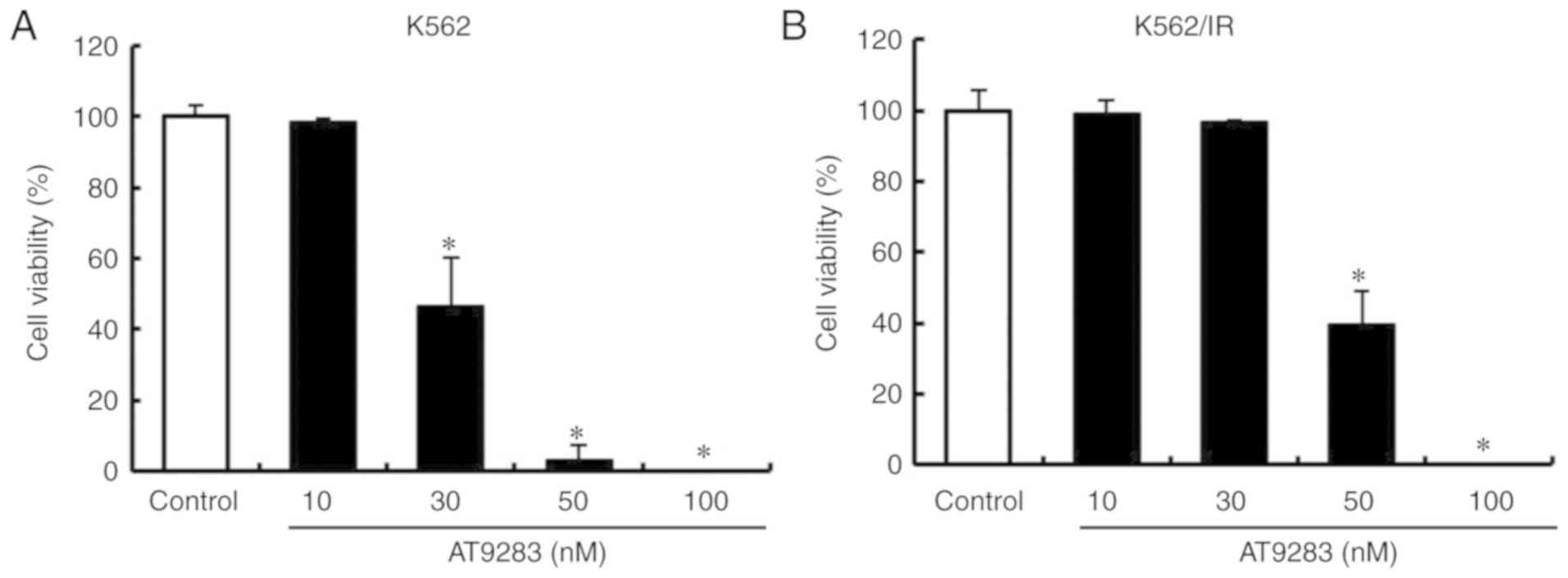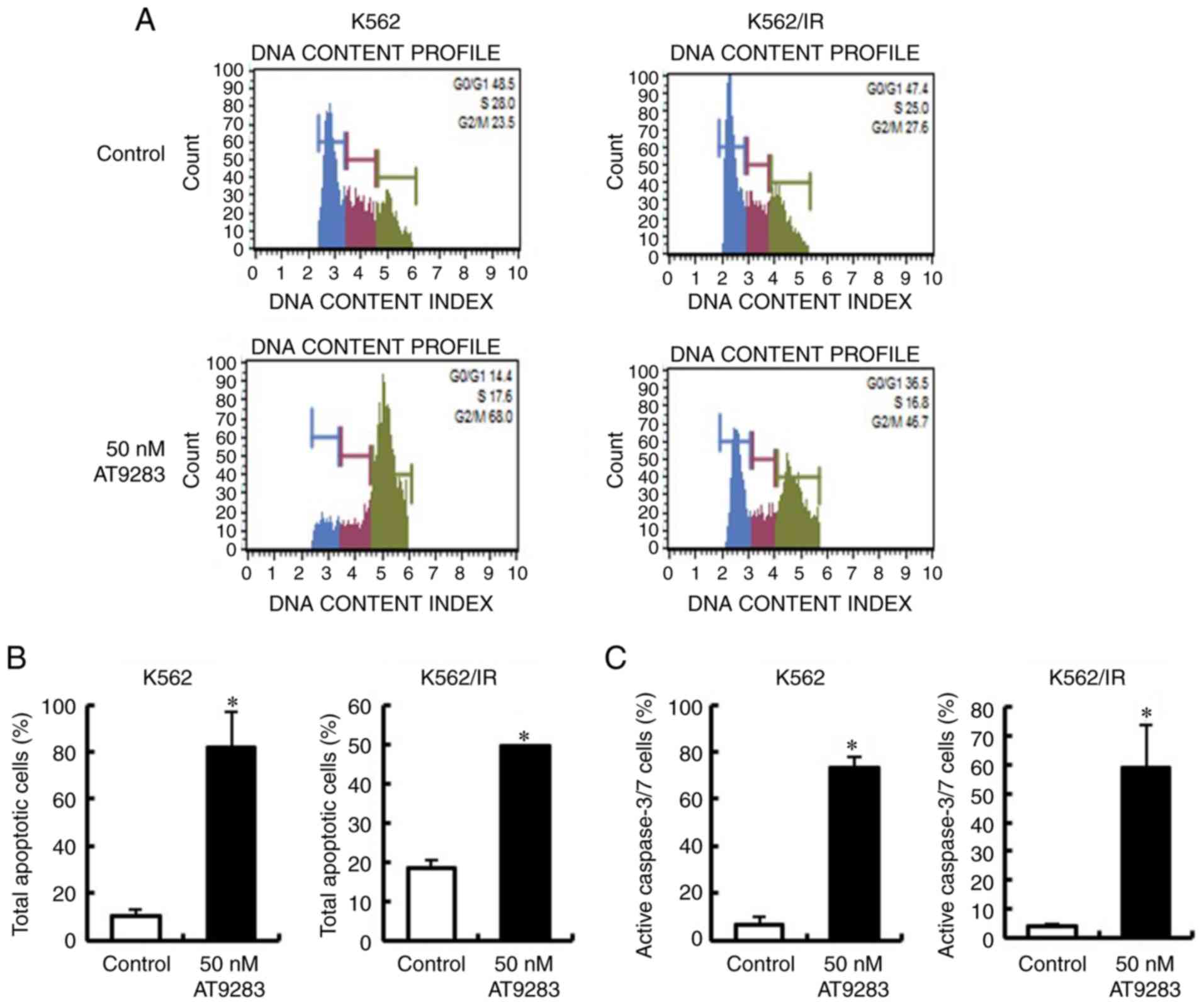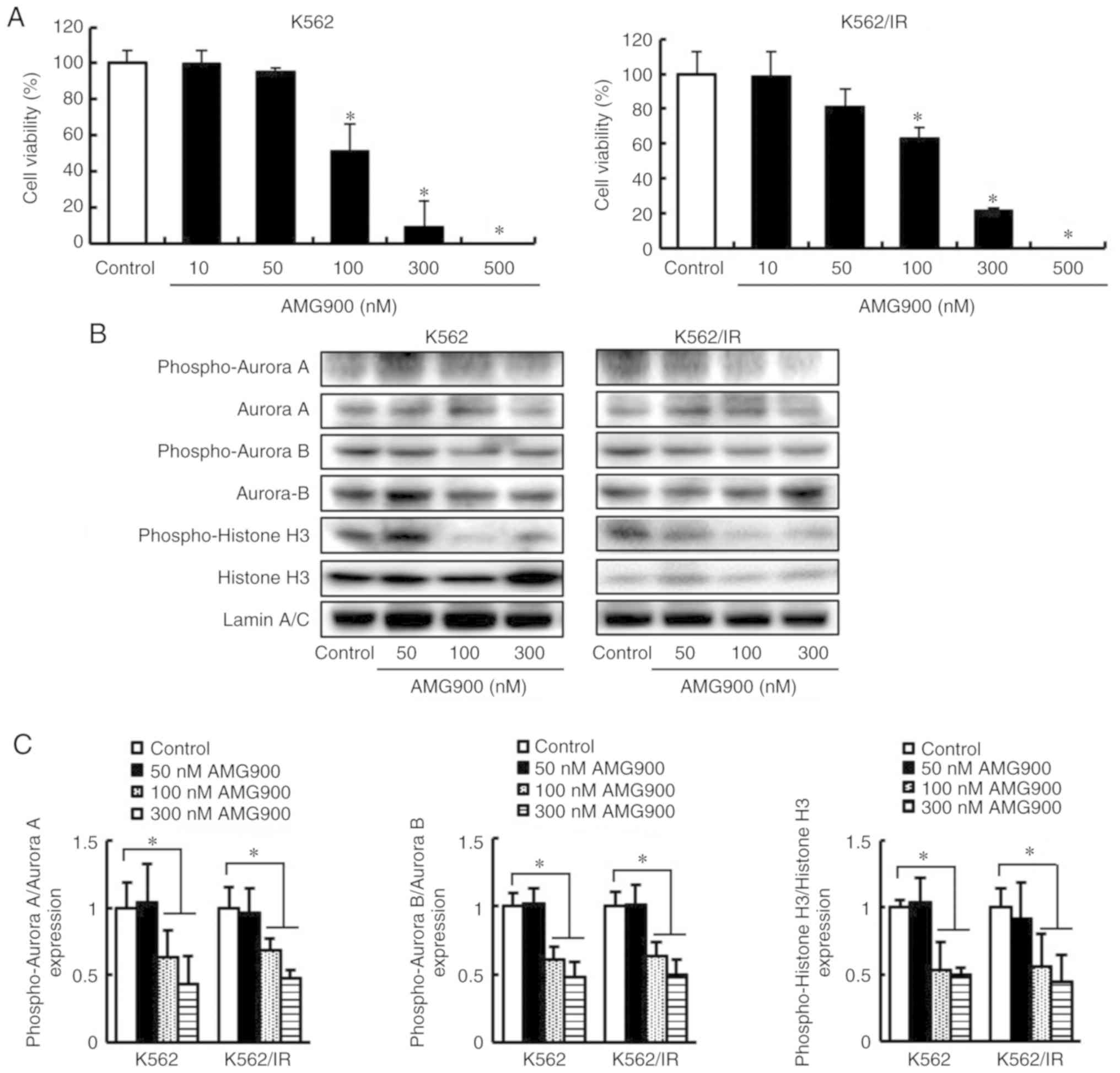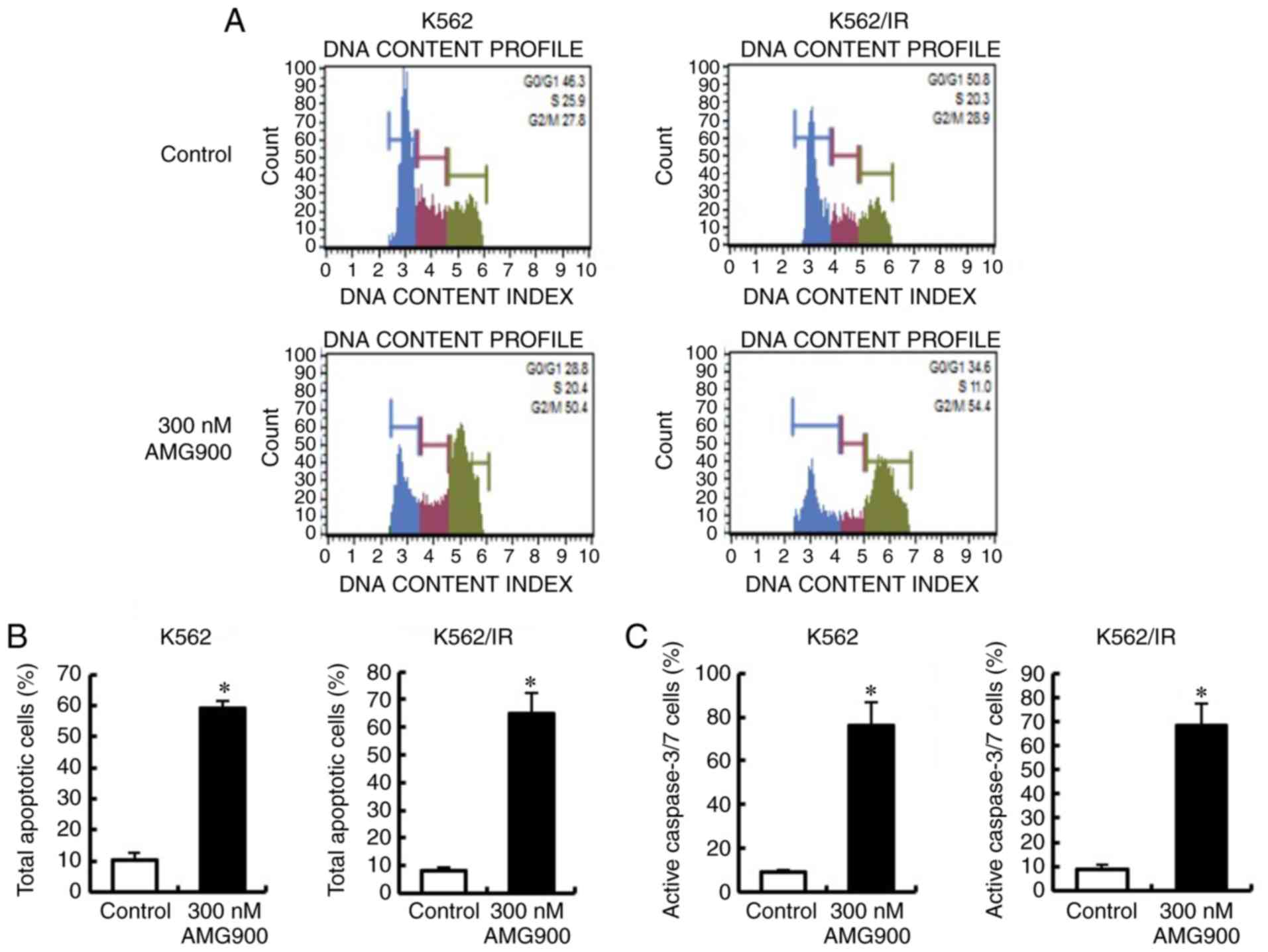|
1
|
Nie ZY, Yang L, Liu XJ, Yang Z, Yang GS,
Zhou J, Qin Y, Yu J, Jiang LL, Wen JK, et al: Morin inhibits
proliferation and induces apoptosis by modulating the
miR-188-5p/PTEN/AKT regulatory pathway in CML cells. Mol Cancer
Ther. 18:2296–2307. 2019. View Article : Google Scholar : PubMed/NCBI
|
|
2
|
Mukaida N, Tanabe Y and Baba T: Chemokines
as a conductor of bone marrow microenvironment in chronic myeloid
leukemia. Int J Mol Sci. 18:18242017. View Article : Google Scholar
|
|
3
|
Chen SH, Chow JM, Hsieh YY, Lin CY, Hsu
KW, Hsieh WS, Chi WM, Shabangu BM and Lee CH: HDAC1,2 knock-out and
HDACi induced cell apoptosis in imatinib-resistant K562 cells. Int
J Mol Sci. 20:22712019. View Article : Google Scholar
|
|
4
|
Chorzalska A, Ahsan N, Rao RSP, Roder K,
Yu X, Morgan J, Tepper A, Hines S, Zhang P, Treaba DO, et al:
Overexpression of Tpl2 is linked to imatinib resistance and
activation of MEK-ERK and NF-κB pathways in a model of chronic
myeloid leukemia. Mol Oncol. 12:630–647. 2018. View Article : Google Scholar : PubMed/NCBI
|
|
5
|
Bhamidipati PK, Kantarjian H, Cortes J,
Cornelison AM and Jabbour E: Management of imatinib-resistant
patients with chronic myeloid leukemia. Ther Adv Hematol.
4:103–117. 2013. View Article : Google Scholar : PubMed/NCBI
|
|
6
|
Sarno F, Pepe G, Termolino P, Carafa V,
Massaro C, Merciai F, Campiglia P, Nebbioso A and Altucci L:
Trifolium Repens blocks proliferation in chronic myelogenous
leukemia via the BCR-ABL/STAT5 pathway. Cells. 9:3792020.
View Article : Google Scholar
|
|
7
|
Buffa P, Romano C, Pandini A, Massimino M,
Tirrò E, Di Raimondo F, Manzella L, Fraternali F and Vigneri PG:
BCR-ABL residues interacting with ponatinib are critical to
preserve the tumorigenic potential of the oncoprotein. FASEB J.
28:1221–1236. 2014. View Article : Google Scholar : PubMed/NCBI
|
|
8
|
Cimino G, Pane F, Elia L, Finolezzi E,
Fazi P, Annino L, Meloni G, Mancini M, Tedeschi A, Di Raimondo F,
et al: The role of BCR/ABL isoforms in the presentation and outcome
of patients with Philadelphia-positive acute lymphoblastic
leukemia: A seven-year update of the GIMEMA 0496 trial.
Haematologica. 91:377–380. 2006.PubMed/NCBI
|
|
9
|
Lin YG, Immaneni A, Merritt WM, Mangala
LS, Kim SW, Shahzad MM, Tsang YT, Armaiz-Pena GN, Lu C, Kamat AA,
et al: Targeting aurora kinase with MK-0457 inhibits ovarian cancer
growth. Clin Cancer Res. 14:5437–5446. 2008. View Article : Google Scholar : PubMed/NCBI
|
|
10
|
Harrington EA, Bebbington D, Moore J,
Rasmussen RK, Ajose-Adeogun AO, Nakayama T, Graham JA, Demur C,
Hercend T, Diu-Hercend A, et al: VX-680, a potent and selective
small-molecule inhibitor of the Aurora kinases, suppresses tumor
growth in vivo. Nat Med. 10:262–267. 2004. View Article : Google Scholar : PubMed/NCBI
|
|
11
|
Matthews N, Visintin C, Hartzoulakis B,
Jarvis A and Selwood DL: Aurora A and B kinases as targets for
cancer: Will they be selective for tumors? Expert Rev Anticancer
Ther. 6:109–120. 2006. View Article : Google Scholar : PubMed/NCBI
|
|
12
|
Lapenna S and Giordano A: Cell cycle
kinases as therapeutic targets for cancer. Nat Rev Drug Discov.
8:547–566. 2009. View
Article : Google Scholar : PubMed/NCBI
|
|
13
|
Rodrigues Alves AP, Machado-Neto JA,
Scheucher PS, Paiva HH, Simões BP, Rego EM and Traina F: Reversine
triggers mitotic catastrophe and apoptosis in K562 cells. Leuk Res.
48:26–31. 2016. View Article : Google Scholar : PubMed/NCBI
|
|
14
|
Gavriilidis P, Giakoustidis A and
Giakoustidis D: Aurora kinases and potential medical applications
of aurora kinase inhibitors: A review. J Clin Med Res. 7:742–751.
2015. View Article : Google Scholar : PubMed/NCBI
|
|
15
|
Ikezoe T, Yang J, Nishioka C, Tasaka T,
Taniguchi A, Kuwayama Y, Komatsu N, Bandobashi K, Togitani K,
Koeffler HP and Taguchi H: A novel treatment strategy targeting
Aurora kinases in acute myelogenous leukemia. Mol Cancer Ther.
6:1851–1857. 2007. View Article : Google Scholar : PubMed/NCBI
|
|
16
|
Tabe Y, Jin L, Iwabuchi K, Wang RY,
Ichikawa N, Miida T, Cortes J, Andreeff M and Konopleva M: Role of
stromal microenvironment in nonpharmacological resistance of CML to
imatinib through Lyn/CXCR4 interactions in lipid rafts. Leukemia.
26:883–892. 2012. View Article : Google Scholar : PubMed/NCBI
|
|
17
|
Zhang X, Tu H, Yang Y, Jiang X, Hu X, Luo
Q and Li J: Bone marrow-derived mesenchymal stromal cells promote
resistance to tyrosine kinase inhibitors in chronic myeloid
leukemia via the IL-7/JAK1/STAT5 pathway. J Biol Chem.
294:12167–12179. 2019. View Article : Google Scholar : PubMed/NCBI
|
|
18
|
Howard S, Berdini V, Boulstridge JA, Carr
MG, Cross DM, Curry J, Devine LA, Early TR, Fazal L, Gill AL, et
al: Fragment-based discovery of the pyrazol-4-yl urea (AT9283), a
multitargeted kinase inhibitor with potent aurora kinase activity.
J Med Chem. 52:379–388. 2009. View Article : Google Scholar : PubMed/NCBI
|
|
19
|
Qi W, Liu X, Cooke LS, Persky DO, Miller
TP, Squires M and Mahadevan D: AT9283, a novel aurora kinase
inhibitor, suppresses tumor growth in aggressive B-cell lymphomas.
Int J Cancer. 130:2997–3005. 2012. View Article : Google Scholar : PubMed/NCBI
|
|
20
|
Tsubaki M, Takeda T, Kino T, Sakai K, Itoh
T, Imano M, Nakayama T, Nishio K, Satou T and Nishida S:
Contributions of MET activation to BCR-ABL1 tyrosine kinase
inhibitor resistance in chronic myeloid leukemia cells. Oncotarget.
8:38717–38730. 2017. View Article : Google Scholar : PubMed/NCBI
|
|
21
|
Tsubaki M, Ogawa N, Takeda T, Sakamoto K,
Shimaoka H, Fujita A, Itoh T, Imano M, Satou T and Nishida S:
Dimethyl fumarate induces apoptosis of hematopoietic tumor cells
via inhibition of NF-κB nuclear translocation and down-regulation
of Bcl-xL and XIAP. Biomed Pharmacother. 68:999–1005. 2014.
View Article : Google Scholar : PubMed/NCBI
|
|
22
|
Tsubaki M, Fujiwara D, Takeda T, Kino T,
Tomonari Y, Itoh T, Imano M, Satou T, Sakaguchi K and Nishida S:
The sensitivity of head and neck carcinoma cells to statins is
related to the expression of their Ras expression status, and
statin-induced apoptosis is mediated via suppression of the Ras/ERK
and Ras/mTOR pathways. Clin Exp Pharmacol Physiol. 44:222–234.
2017. View Article : Google Scholar : PubMed/NCBI
|
|
23
|
Takeda T, Tsubaki M, Tomonari Y, Kawashima
K, Itoh T, Imano M, Satou T and Nishida S: Bavachin induces the
apoptosis of multiple myeloma cell lines by inhibiting the
activation of nuclear factor kappa B and signal transducer and
activator of transcription 3. Biomed Pharmacother. 100:486–494.
2018. View Article : Google Scholar : PubMed/NCBI
|
|
24
|
Santo L, Hideshima T, Cirstea D, Bandi M,
Nelson EA, Gorgun G, Rodig S, Vallet S, Pozzi S, Patel K, et al:
Antimyeloma activity of a multitargeted kinase inhibitor, AT9283,
via potent Aurora kinase and STAT3 inhibition either alone or in
combination with lenalidomide. Clin Cancer Res. 17:3259–3271. 2011.
View Article : Google Scholar : PubMed/NCBI
|
|
25
|
Liang H and Wang M: MET oncogene in
non-small cell lung cancer: Mechanism of MET dysregulation and
agents targeting the HGF/c-Met axis. Onco Targets Ther.
13:2491–2510. 2020. View Article : Google Scholar : PubMed/NCBI
|
|
26
|
Hirota T, Kunitoku N, Sasayama T, Marumoto
T, Zhang D, Nitta M, Hatakeyama K and Saya H: Aurora-A and an
interacting activator, the LIM protein Ajuba, are required for
mitotic commitment in human cells. Cell. 114:585–598. 2003.
View Article : Google Scholar : PubMed/NCBI
|
|
27
|
Tao Y, Zhang P, Girdler F, Frascogna V,
Castedo M, Bourhis J, Kroemer G and Deutsch E: Enhancement of
radiation response in p53-deficient cancer cells by the Aurora-B
kinase inhibitor AZD1152. Oncogene. 27:3244–3255. 2008. View Article : Google Scholar : PubMed/NCBI
|
|
28
|
Crosio C, Fimia GM, Loury R, Kimura M,
Okano Y, Zhou H, Sen S, Allis CD and Sassone-Corsi P: Mitotic
phosphorylation of histone H3: Spatio-temporal regulation by
mammalian Aurora kinases. Mol Cell Biol. 22:874–885. 2002.
View Article : Google Scholar : PubMed/NCBI
|
|
29
|
Marumoto T, Honda S, Hara T, Nitta M,
Hirota T, Kohmura E and Saya H: Aurora-A kinase maintains the
fidelity of early and late mitotic events in HeLa cells. J Biol
Chem. 278:51786–51795. 2003. View Article : Google Scholar : PubMed/NCBI
|
|
30
|
Giet R and Glover DM: Drosophila aurora B
kinase is required for histone H3 phosphorylation and condensin
recruitment during chromosome condensation and to organize the
central spindle during cytokinesis. J Cell Biol. 152:669–682. 2001.
View Article : Google Scholar : PubMed/NCBI
|
|
31
|
Curry J, Angove H, Fazal L, Lyons J, Reule
M, Thompson N and Wallis N: Aurora B kinase inhibition in mitosis:
Strategies for optimising the use of aurora kinase inhibitors such
as AT9283. Cell Cycle. 8:1921–1929. 2009. View Article : Google Scholar : PubMed/NCBI
|
|
32
|
Payton M, Bush TL, Chung G, Ziegler B,
Eden P, McElroy P, Ross S, Cee VJ, Deak HL, Hodous BL, et al:
Preclinical evaluation of AMG 900, a novel potent and highly
selective pan-aurora kinase inhibitor with activity in
taxane-resistant tumor cell lines. Cancer Res. 70:9846–9854. 2010.
View Article : Google Scholar : PubMed/NCBI
|
|
33
|
Chakravarty A, Shinde V, Tabernero J,
Cervantes A, Cohen RB, Dees EC, Burris H, Infante JR, Macarulla T,
Elez E, et al: Phase I assessment of new mechanism-based
pharmacodynamic biomarkers for MLN8054, a small-molecule inhibitor
of Aurora A kinase. Cancer Res. 71:675–685. 2011. View Article : Google Scholar : PubMed/NCBI
|
|
34
|
Malumbres M and Pérez de Castro I: Aurora
kinase A inhibitors: Promising agents in antitumoral therapy.
Expert Opin Ther Targets. 18:1377–1393. 2014.PubMed/NCBI
|
|
35
|
Zhang XH, Rao M, Loprieato JA, Hong JA,
Zhao M, Chen GZ, Humphries AE, Nguyen DM, Trepel JB, Yu X and
Schrump DS: Aurora A, Aurora B and survivin are novel targets of
transcriptional regulation by histone deacetylase inhibitors in
non-small cell lung cancer. Cancer Biol Ther. 7:1388–1397. 2009.
View Article : Google Scholar
|
|
36
|
Vader G and Lens SM: The Aurora kinase
family in cell division and cancer. Biochim Biophys Acta.
1786:60–72. 2008.PubMed/NCBI
|
|
37
|
Tanaka M, Ueda A, Kanamori H, Ideguchi H,
Yang J, Kitajima S and Ishigatsubo Y: Cell-cycle-dependent
regulation of human aurora A transcription is mediated by periodic
repression of E4TF1. J Biol Chem. 277:10719–10726. 2002. View Article : Google Scholar : PubMed/NCBI
|
|
38
|
Kimura M, Uchida C, Takano Y, Kitagawa M
and Okano Y: Cell cycle-dependent regulation of the human aurora B
promoter. Biochem Biophys Res Commun. 316:930–936. 2004. View Article : Google Scholar : PubMed/NCBI
|
|
39
|
Kantarjian HM, Talpaz M, Giles F, O'Brien
S and Cortes J: New insights into the pathophysiology of chronic
myeloid leukemia and imatinib resistance. Ann Intern Med.
145:913–923. 2006. View Article : Google Scholar : PubMed/NCBI
|
|
40
|
Zhou T, Commodore L, Huang WS, Wang Y,
Thomas M, Keats J, Xu Q, Rivera VM, Shakespeare WC, Clackson T, et
al: Structural mechanism of the Pan-BCR-ABL inhibitor ponatinib
(AP24534): Lessons for overcoming kinase inhibitor resistance. Chem
Biol Drug Des. 77:1–11. 2011. View Article : Google Scholar : PubMed/NCBI
|
|
41
|
Branford S, Melo JV and Hughes TP:
Selecting optimal second-line tyrosine kinase inhibitor therapy for
chronic myeloid leukemia patients after imatinib failure: Does the
BCR-ABL mutation status really matter? Blood. 114:5426–5435. 2009.
View Article : Google Scholar : PubMed/NCBI
|
|
42
|
Lan X, Zhao C, Chen X, Zhang P, Zang D, Wu
J, Chen J, Long H, Yang L, Huang H, et al: Platinum pyrithione
induces apoptosis in chronic myeloid leukemia cells resistant to
imatinib via DUB inhibition-dependent caspase activation and
Bcr-Abl downregulation. Cell Death Dis. 8:e29132017. View Article : Google Scholar : PubMed/NCBI
|



















